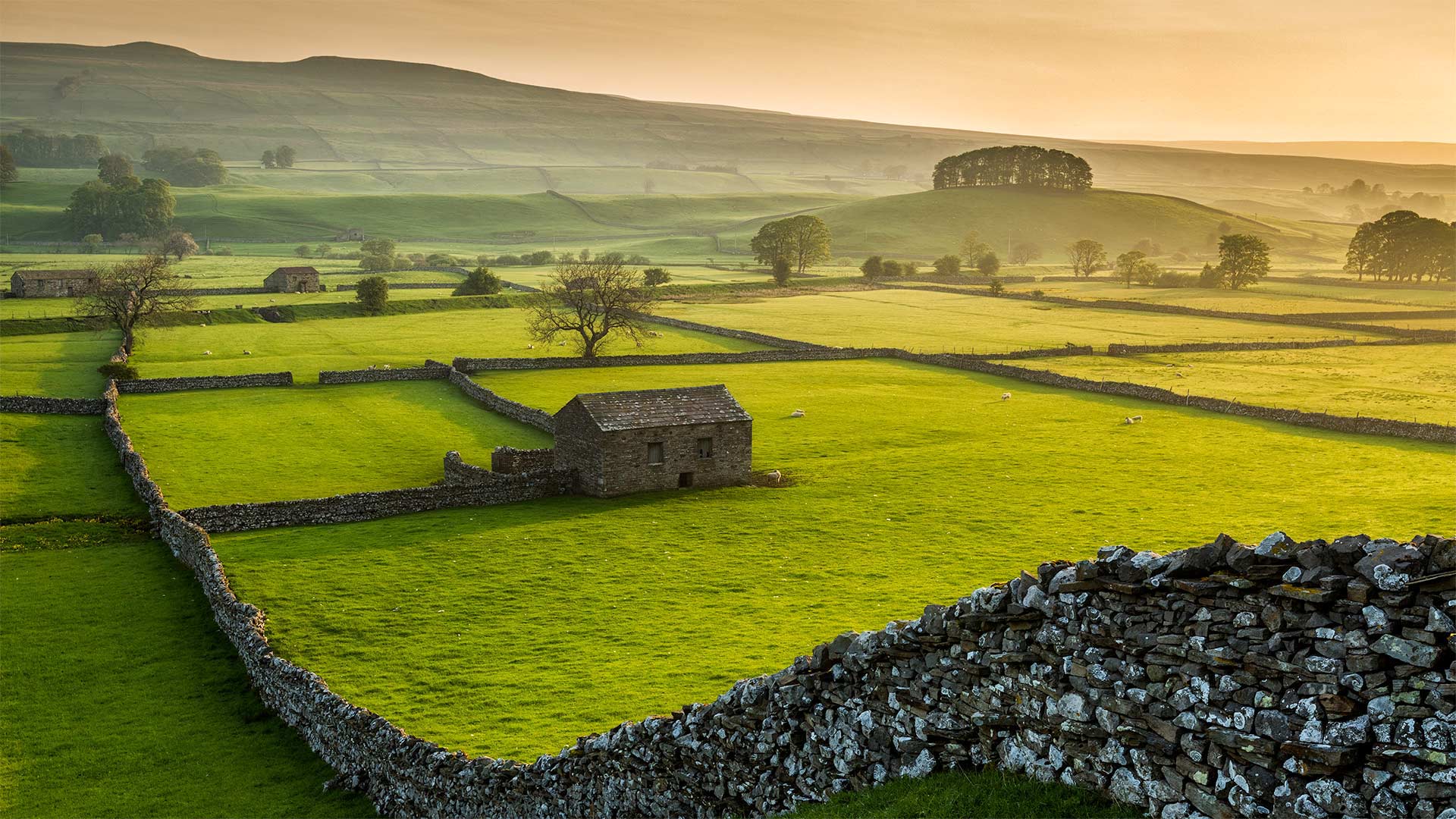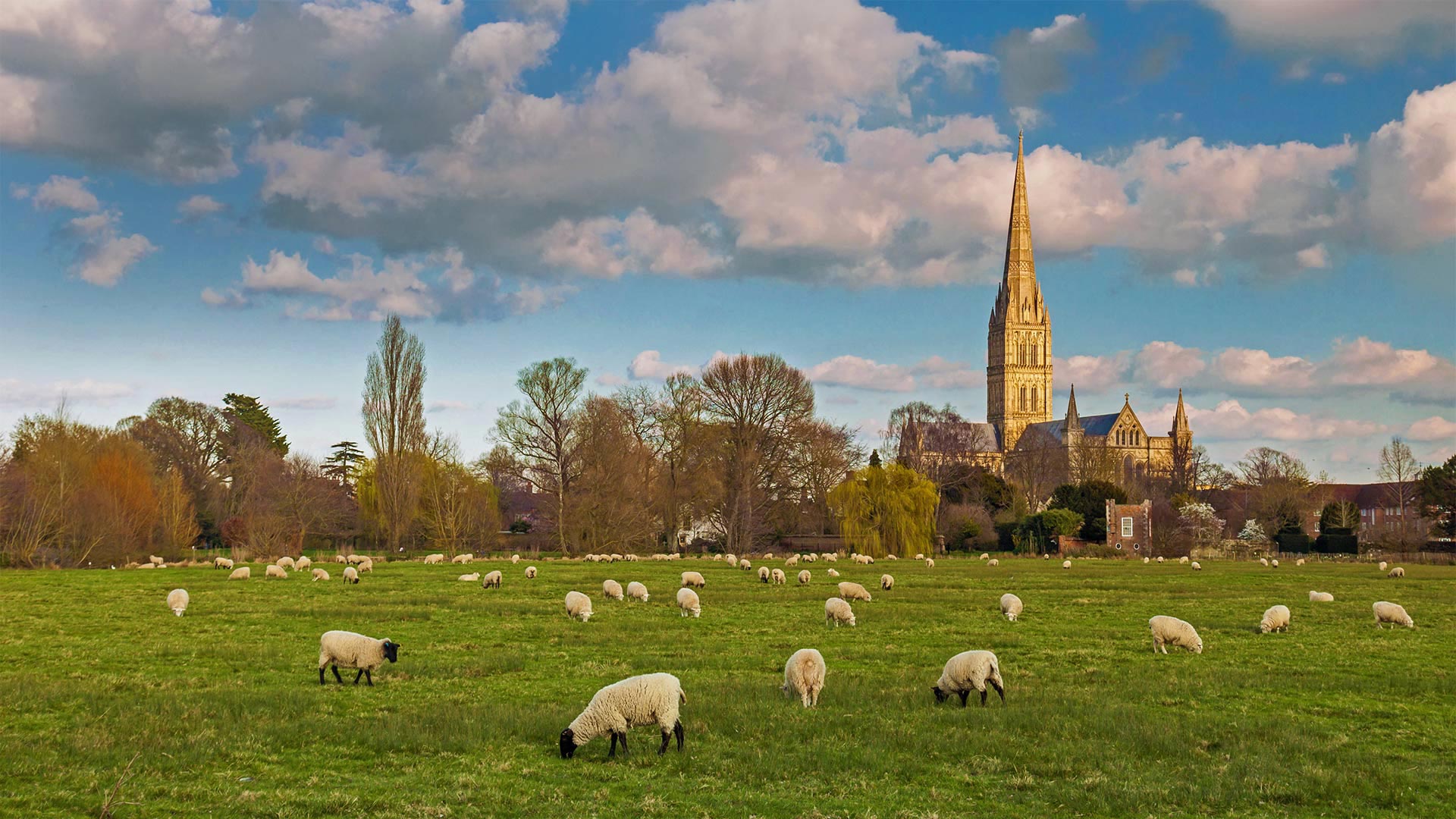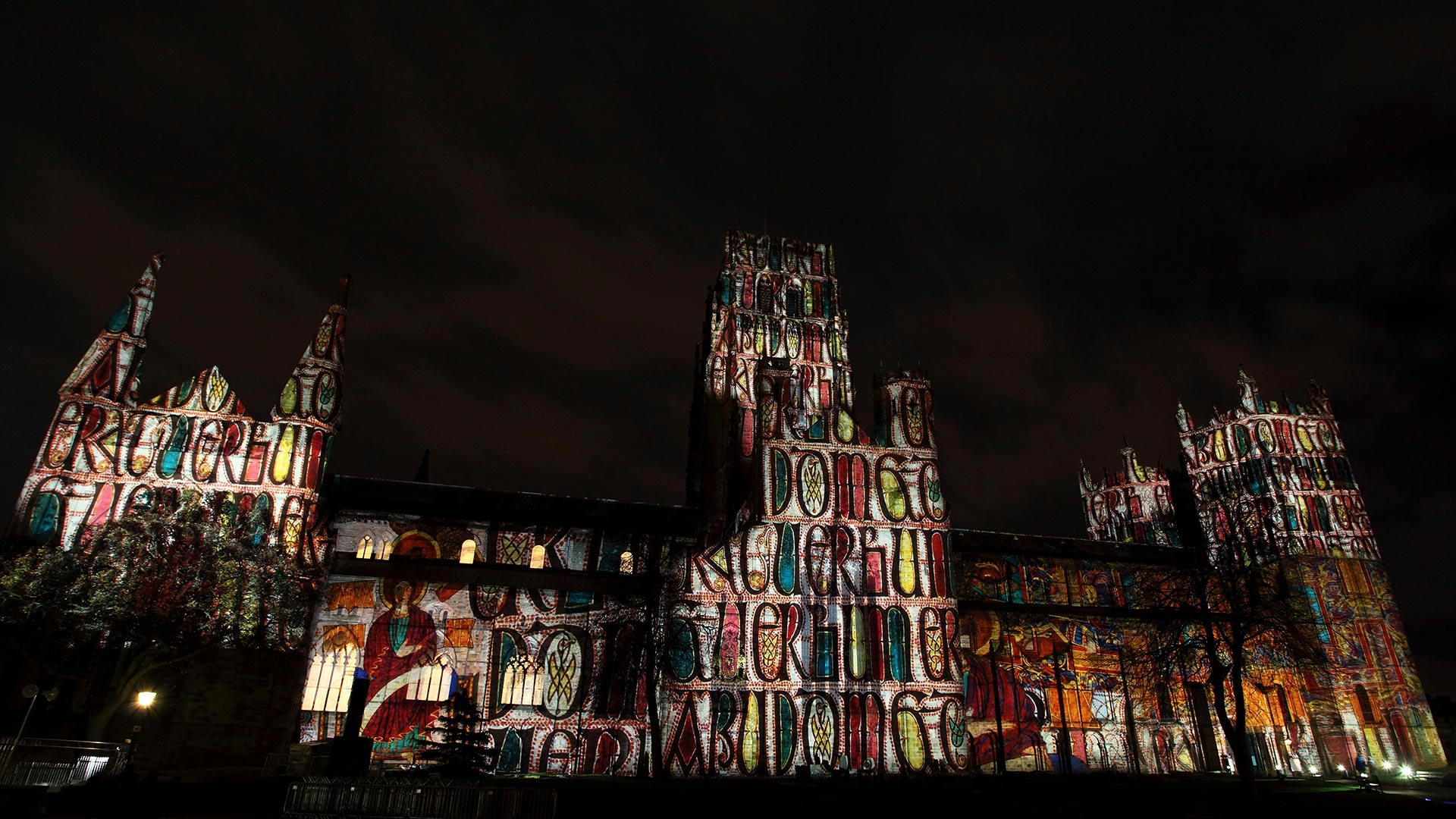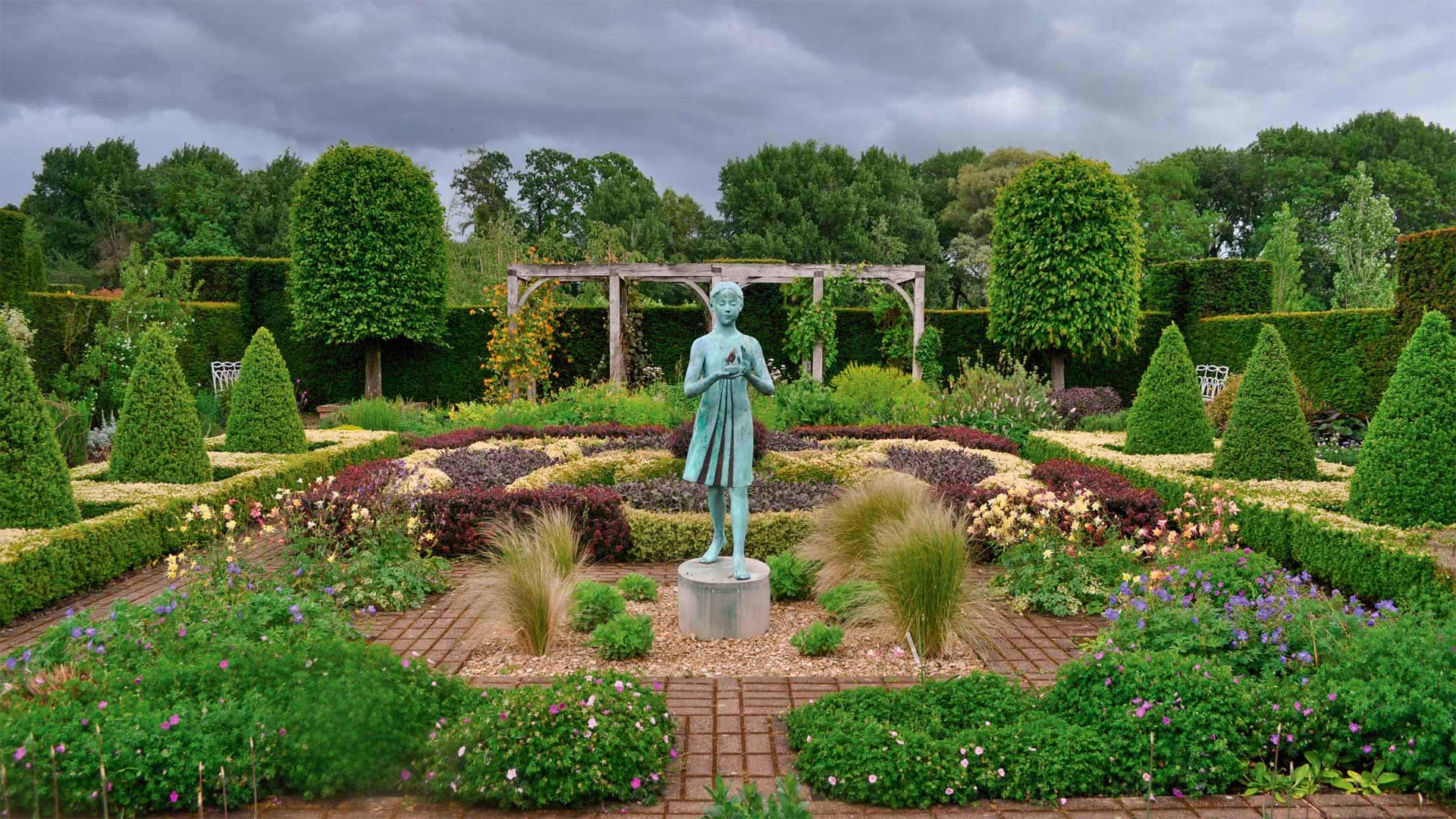文斯利代尔,英格兰约克郡谷地国家公园 Wensleydale, Yorkshire Dales National Park, North Yorkshire, England (© Guy Edwardes/Minden Pictures)

文斯利代尔,英格兰约克郡谷地国家公园 Wensleydale, Yorkshire Dales National Park, North Yorkshire, England (© Guy Edwardes/Minden Pictures)
'Cheese! We'll go somewhere where there's cheese!'
Ahh, the pastoral countryside of the Yorkshire Dales in Northern England. Dewey mornings, grazing farm animals, hand-built dry stone walls, and…cheese? Well, if you're a fan of the beloved British claymation series 'Wallace & Gromit,' then you may have first heard of this area of the Yorkshires, Wensleydale, because of its local cheese. In fact, the animated duo's notorious affinity for the local curd--which Wallace likes because producers thought it makes his face look 'nice and toothy'—became so widespread that it helped the Wensleydale cheesemakers stave off bankruptcy.
Cheese aside, another staple of Wensleydale, and the surrounding Yorkshire Dales National Park, are the 5,000 miles of dry stone walls that have crisscrossed the landscape for centuries. The walls were built by farmers to delineate boundaries, clarify land ownership, and more practically, to keep their cows and sheep from wandering off. The walls are considered 'dry' because they were built with no mortar to bind the stones together. Larger stones form a base for the wall, upon which smaller stones are stacked to create two parallel wall faces, constructed simultaneously. More stones are then used to fill in the gap between the two wall faces, with gravity doing the rest. While that may sound flimsy, a well-constructed dry stone wall can last at least 100 years.
“奶酪!我们要去有奶酪的地方
啊,英格兰北部约克郡山谷的田园乡村。杜威的早晨,放牧的农场动物,手工建造的干石墙,还有……奶酪?好吧,如果你是一个喜爱的英国粘土系列'华莱士和格罗米特'的粉丝,那么你可能第一次听说这个地区的约克郡,温斯莱代尔,因为它的当地奶酪。事实上,这对动画片中的二人组对当地乳酪臭名昭著的亲和力——华莱士喜欢这种乳酪,因为制作人认为这种乳酪能让他的脸看起来“又漂亮又有牙齿”——变得如此广泛,这帮助温斯利代尔奶酪制造商避免了破产。
除了奶酪之外,温斯莱代尔的另一大主食,以及周围的约克郡戴尔国家公园,都是绵延5000英里的干石墙,几个世纪以来,这些石墙纵横交错。这些围墙是由农民建造的,目的是划定边界,明确土地所有权,更实际的是,防止他们的牛羊四处游荡。这些墙被认为是“干的”,因为它们建造时没有用砂浆将石头粘合在一起。较大的石头形成墙的基础,较小的石头堆放在上面,形成两个平行的墙面,同时建造。然后用更多的石头填充两个墙面之间的缝隙,剩下的部分由重力来完成。虽然这听起来很脆弱,但一座建造良好的干石墙至少可以使用100年。
莱姆里杰斯的Cobb防波堤,英格兰多塞特 The Cobb breakwater, Lyme Regis, Dorset, England (© Ross Hoddinott/Offset by Shutterstock)

莱姆里杰斯的Cobb防波堤,英格兰多塞特 The Cobb breakwater, Lyme Regis, Dorset, England (© Ross Hoddinott/Offset by Shutterstock)
Holding back the tide
Shrugging off choppy waters on England’s south-west coast is the historic harbour and breakwater known as the Cobb. There has been one man-made structure or another in the waters off Lyme Regis since medieval times, without which much of this Dorset town may have been washed away. While its harbour seems small to modern eyes, Lyme Regis grew as a major port and shipbuilding centre from the 13th century onwards, thanks to the Cobb and the protection it offered from fierce south-westerly gales.
The long, curving High Wall featured in our homepage image offers a great lookout spot from which to enjoy panoramic views of this stretch of the Jurassic Coast, a World Heritage Site famous for its fossils. This section, built in Portland Stone, dates back to the 1820s and famously features in a scene with Meryl Streep’s character in The French Lieutenant’s Woman. If you choose to follow in her footsteps, be warned: The Cobb can be as treacherous as it is breathtaking, even when waves are not crashing against it. Algae can make its surface slippery and there is no handrail to grab if you lose your footing, so choose a calm day to enjoy a stroll along the top and even then, tread carefully.
抑制潮流
在英格兰西南海岸的波涛汹涌的海面上耸肩的是历史悠久的港口和被称为科布的防波堤。自中世纪以来,莱姆里吉斯附近的水域就有这样或那样的人造建筑,如果没有这些建筑,多塞特镇的大部分地区可能会被冲走。在现代人看来,莱姆雷吉斯的港口似乎很小,但从13世纪起,由于科布和它所提供的抵御西南狂风的保护,莱姆雷吉斯逐渐成为一个主要的港口和造船中心。
在我们的主页图片中,长而弯曲的高墙提供了一个绝佳的了望点,从这里可以欣赏侏罗纪海岸的全景,侏罗纪海岸是一个以化石闻名的世界遗产地。这一部分建于波特兰石,可以追溯到19世纪20年代,以梅丽尔·斯特里普在《法国中尉的女人》中的角色而闻名。如果你选择跟随她的脚步,要注意的是:柯布可能是危险的,因为它是惊人的,即使海浪没有撞击它。藻类会使它的表面很滑,如果你失去了你的脚,没有扶手可以抓住,所以选择一个平静的一天享受漫步沿顶部,即使这样,踏步小心。
索尔茲伯里大教堂与放牧的羊群,英格兰 Salisbury Cathedral with grazing flock of sheep, England (© Slawek Staszczuk Photo/Alamy)

索尔茲伯里大教堂与放牧的羊群,英格兰 Salisbury Cathedral with grazing flock of sheep, England (© Slawek Staszczuk Photo/Alamy)
Happy 800th, Salisbury Cathedral
We're in the English county of Wiltshire to celebrate the 800th anniversary of Salisbury Cathedral—the towering marvel of Early English Gothic design rising behind these contentedly grazing sheep. The massive church's first foundation stones were laid here in Salisbury—then called New Sarum—on April 28, 1220. The structure itself dates back even further, the bulk of it having been moved over a mile piece by piece from the former Roman stronghold of Old Sarum.
The building's main body was complete by the time the cathedral was consecrated in 1258, and the magnificent spire was finished in its centennial year, in 1320. Even taller towers were built for cathedrals in London and Lincoln, but the Salisbury spire outlived both of those and, for more than four centuries now, has been the tallest church spire in England.
波特兰比尔灯塔处的晨光和海浪,英格兰多塞特郡 (© Lee Pengelly/Getty Images Plus)
夕阳下的椋鸟,英格兰布莱克浦 Starlings at sunset in Blackpool, England (© Mediaworld Images/Alamy)

夕阳下的椋鸟,英格兰布莱克浦 Starlings at sunset in Blackpool, England (© Mediaworld Images/Alamy)
Mesmerizing murmuration
Around this time of year, as temperatures dip in the Northern Hemisphere, European or common starlings put on a dazzling show. Most of the time, these noisy birds are scorned for their bullying behavior at the birdfeeder. But in autumn months, they gather to roost in huge flocks, like here in Blackpool, England. At dusk, the starlings take flight en masse and flock together in a hypnotizing, swirling cloud of fluttering wings. This behavior is called mumuration. It's thought to help keep the birds warm while also acting as a defensive tactic to confuse predators like hawks and falcons. But maybe the raptors are just awestruck by the starlings' synchronized spectacle like the rest of us.
The 'Crown of Light' installation is projected onto Durham Cathedral during the 2013 Lumiere Durham festival in England (© Stuart Forster/Alamy)

The 'Crown of Light' installation is projected onto Durham Cathedral during the 2013 Lumiere Durham festival in England (© Stuart Forster/Alamy)
The perfect canvas for an ancient text
Since 2009, the city of Durham has served as a grand stage for the biennial Lumiere Durham festival. During four days in November, works of 'son et lumière'—a French phrase that means 'sound and light'—provide spectators with new ways of viewing public spaces and buildings. Artists from around the world design large-scale light shows paired with narratives and sound effects. It's become the UK's largest light festival, and Lumiere Durham's 10th anniversary, which begins today, promises to attract more than 200,000 people to enjoy the illuminated artworks along cobbled streets.
This image from the 2013 festival shows 'Crown of Light,' a work that projects an ancient Christian manuscript called the Lindisfarne Gospels onto the exterior walls of the Durham Cathedral. The original manuscript, considered one of the world's oldest and finest examples of medieval European book paintings, was brought to the Durham area in the 9th century by monks who had fled their monastery in Lindisfarne, off the coast of Northumberland, to avoid Viking raids. The Lindisfarne Gospels is considered an illuminated manuscript because the book is painted in gold and silver with miniature illustrations and ornate border art. But at the festival, the term gets a new meaning as the illuminated manuscript lights up the cathedral for thousands of spectators to see.
埃克斯穆尔国家公园斯托克佩罗公地,英国英格兰 Stoke Pero Common, Exmoor National Park, England, UK (© David Noton/Alamy)

埃克斯穆尔国家公园斯托克佩罗公地,英国英格兰 Stoke Pero Common, Exmoor National Park, England, UK (© David Noton/Alamy)
The wild romance of Exmoor
Welcome to Exmoor National Park, a patchwork of landscapes covering 267 square miles of south-west England. Here, grassy open moorland and heather-covered hills nestle up against wooded valleys, streams, waterfalls, farmland and some of the highest sea cliffs in the country – scenery which inspired RD Blackmore's 1869 historical romance novel Lorna Doone.
From Exmoor's highest point on Dunkery Hill – pictured in today's image - visitors can get sweeping views stretching from Dartmoor in the south up to the Bristol Channel and beyond on a clear day, while at night, Exmoor offers one of the best stargazing spots in the UK as an International Dark Sky Reserve.
The park is also home to a large variety of wildlife including Exmoor ponies - which roam freely on the moor – rare butterflies, otters and wild red deer, a nod to Exmoor's past as an ancient royal forest. But keep your eyes peeled for the legendary Beast of Exmoor, a huge puma or panther-like creature which some claim to have spotted roaming the moors.
德比郡高峰区的Winnats山口,英格兰 (© Christopher Drabble/Alamy)
Artist Luke Jerram's installation 'Museum of the Moon' at Liverpool Cathedral, England (© Christopher Furlong/Getty Images)

Artist Luke Jerram's installation 'Museum of the Moon' at Liverpool Cathedral, England (© Christopher Furlong/Getty Images)
Bringing the moon to earth
It was fifty years ago that Neil Armstrong and Buzz Aldrin became the first humans to feel an alien gravity tugging at them. By landing on the moon on July 20, 1969, a mere 66 years after the first powered flight by the Wright brothers, the two astronauts met the challenge set by John F. Kennedy seven years earlier to land men on the moon before the end of the decade.
In the decades since, NASA and other space agencies around the world have continued to study our satellite companion to unlock its secrets. Those studies produced the detailed images and maps that British artist Luke Jerram used to produce his 23-foot-diameter sculpture Museum of the Moon (shown here in Liverpool Cathedral). The amazingly detailed installation is currently on display the Houston Museum of Natural Science as part of the 50th anniversary celebrations of the Apollo 11 moon landing.
Waterperry花园,英国牛津郡 Waterperry Gardens in Oxfordshire, England (© Lauren Hibbit/Danita Delimont)

Waterperry花园,英国牛津郡 Waterperry Gardens in Oxfordshire, England (© Lauren Hibbit/Danita Delimont)
A learning garden
Today we're in Waterperry Gardens in Oxfordshire, England. The gardens have gone through many changes since 1931, when Beatrix Havergal and Avice Sanders first began turning the grounds of a country house into an educational public garden. (Waterperry grew much-needed produce during World War II.) The gardening school at Waterperry closed in 1971, and now the land is owned and operated by the School of Economic Science, which uses some of the buildings for study projects and retreats. Waterperry is a wonderful example of classic English gardening. Visitors can stroll through the aromatic ‘knot garden' seen on our homepage today, or explore other parts of the gardens, including orchards, a nursery, and a museum.

